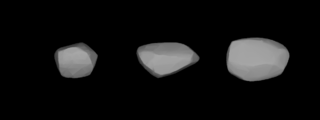
Dido is a main-belt asteroid with a diameter of 179±1 km. It was discovered by C. H. F. Peters on October 22, 1879, in Clinton, New York and was named after the mythical Carthaginian queen Dido. This asteroid is orbiting the Sun at a distance of 3.15 AU with an eccentricity (ovalness) of 0.058 and a period of 5.59 yr. The orbital plane is tilted at an angle of 7.2° to the plane of the ecliptic.

Atropos is a typical Main belt asteroid that was discovered by Austrian astronomer Johann Palisa on 8 March 1888 in Vienna.

Rosalia is a large Main belt asteroid. It was discovered by Auguste Charlois on 1 September 1891 in Nice.

Corduba is a very large main-belt asteroid that was discovered by the French astronomer Auguste Charlois on 21 March 1893 from Nice. It is classified as a C-type asteroid and is probably composed of carbonaceous material.

402 Chloë is a large main-belt asteroid. It was discovered by French astronomer Auguste Charlois on 21 March 1895 from Nice. This asteroid is orbiting the Sun at a distance of 2.56 AU with a period of 4.09 years and an eccentricity of 0.11. The orbital plane is inclined at an angle of 11.8° to the plane of the ecliptic.

Aspasia is a large main-belt asteroid that was discovered by French astronomer Auguste Charlois on 9 December 1895 in Nice. It is classified as a CX-type asteroid.
Cheruskia is a minor planet, specifically an asteroid orbiting in the asteroid belt that was discovered by German astronomer Paul Götz on 26 July 1905 from Heidelberg.

Rebekka is a minor planet orbiting the Sun, which was discovered on September 19, 1905, by a German astronomer Paul Götz in Heidelberg. It was named after a young lady from Heidelberg, and may have been inspired by the asteroid's provisional designation 1905 RB.
Bilkis is a minor planet, specifically an asteroid orbiting in the asteroid belt. It was discovered by German astronomer August Kopff in 1906 February and was given the Koran name for the Queen of Sheba. Photometric observations at the Palmer Divide Observatory in Colorado Springs, Colorado in 2006–7 were used to build a light curve for this object. The asteroid displayed a rotation period of 8.5742 ± 0.0005 hours and a brightness variation of 0.40 ± 0.02 in magnitude.

Juvisia is a minor planet, specifically an asteroid orbiting in the asteroid belt that was discovered 27 August 1906 in Heidelberg by German astronomer Max Wolf. It was named after the commune Juvisy-sur-Orge, France, where French astronomer Camille Flammarion had his observatory.
607 Jenny is a minor planet, specifically an asteroid orbiting in the asteroid belt that was discovered by German astronomer August Kopff on September 18, 1906.
620 Drakonia is a minor planet, specifically an asteroid orbiting in the asteroid belt. It was discovered October 26, 1906, in Taunton, Massachusetts, by American astronomer Joel Hastings Metcalf and given the preliminary designation 1906 WE. It may have been named for Drake University.
630 Euphemia is a mid-sized Eunomian asteroid.
687 Tinette is a minor planet, specifically an asteroid orbiting primarily in the asteroid belt. It was discovered by Austrian astronomer Johann Palisa on 16 August 1909 from Vienna and was given the preliminary designation 1909 HG.

708 Raphaela is a minor planet orbiting the Sun.
790 Pretoria is a minor planet orbiting the Sun that was discovered by English astronomer Harry Edwin Wood on January 16, 1912. It is a member of the Cybele group located beyond the core of the main belt and named after Pretoria, the capital city of South Africa.
840 Zenobia is a minor planet orbiting the Sun. It was discovered by German astronomer Max Wolf at Heidelberg on September 25, 1916. The origin of the name is uncertain, but it may be named after the Slavic god of the hunt.
829 Academia is a minor planet orbiting the Sun. The asteroid is roughly 44 km in diameter and has a low albedo. Photometric measurements of the asteroid made in 2005 at the Palmer Divide Observatory showed a light curve with a period of 7.891 ± 0.005 hours and a brightness variation of 0.44 ± 0.02 in magnitude.
947 Monterosa is a minor planet orbiting the Sun.
2131 Mayall is an inner main-belt asteroid discovered on September 3, 1975, by Arnold Klemola at the Lick Observatory and named in honor of Nicholas U. Mayall (1906–1993), director of the Kitt Peak National Observatory during 1960–1971, who also worked at Lick for many years. It is about 8 km in diameter.










